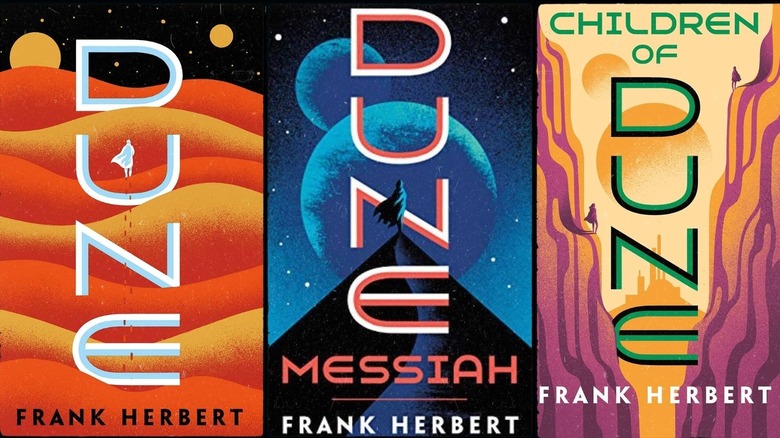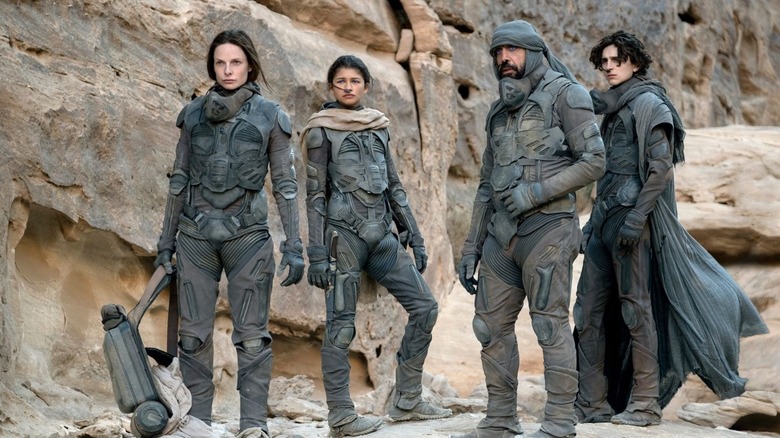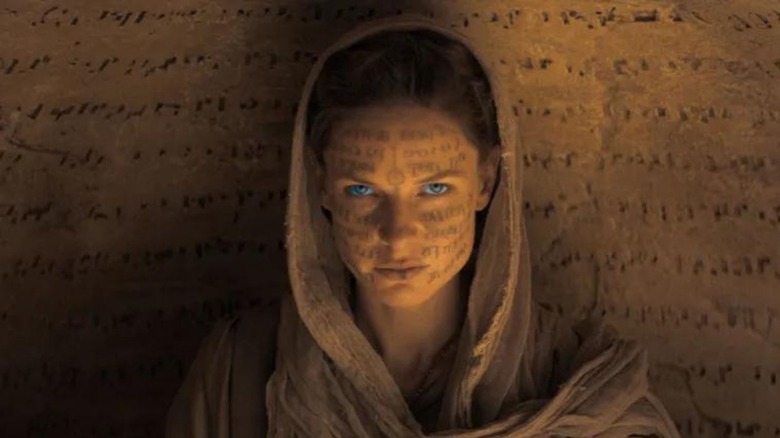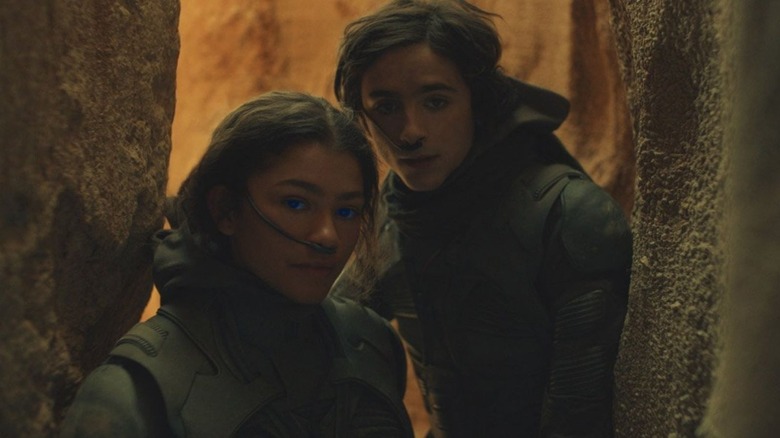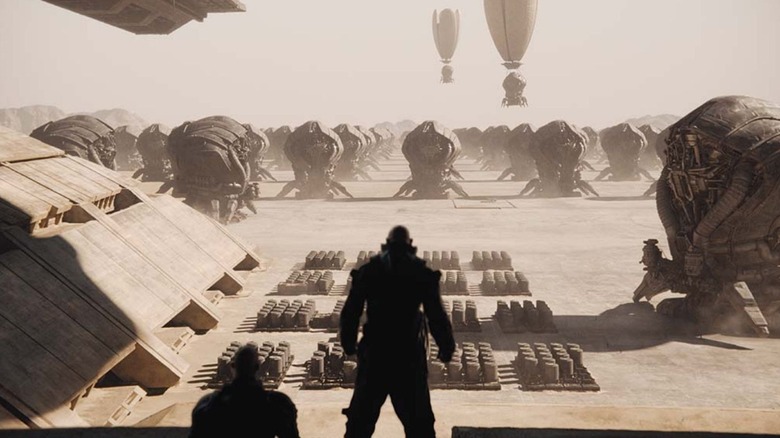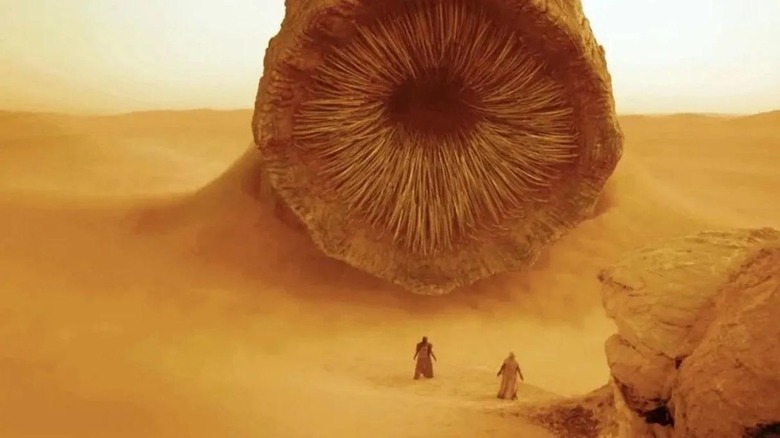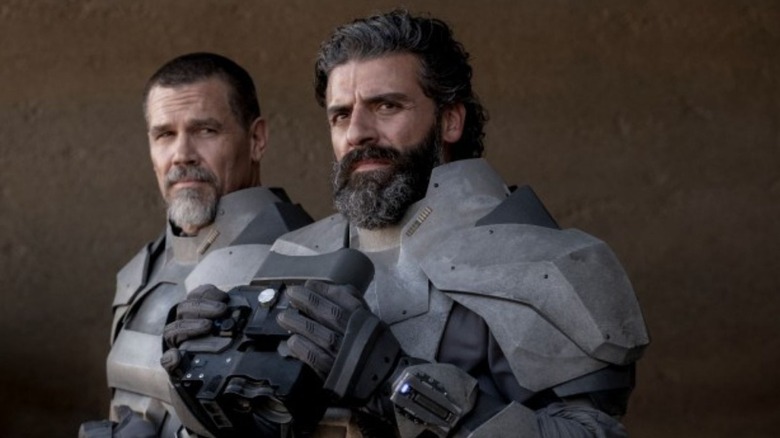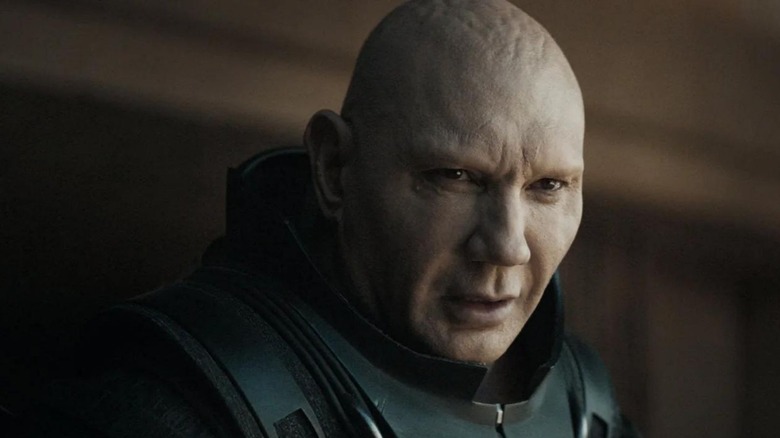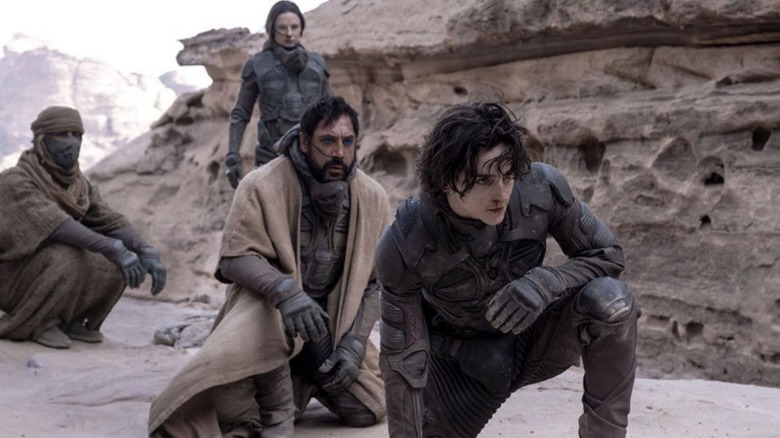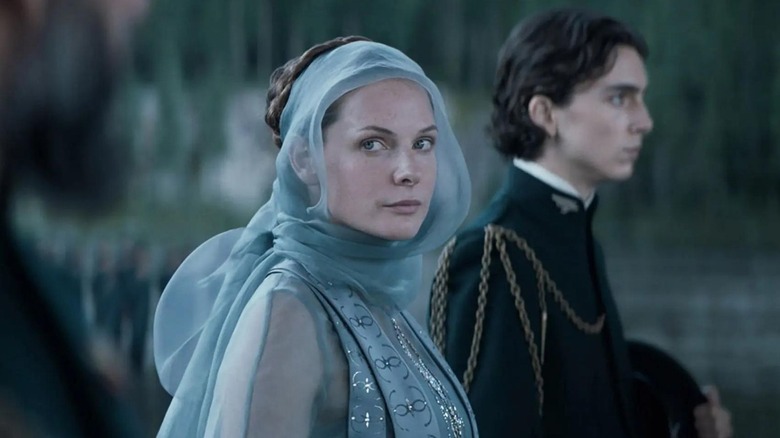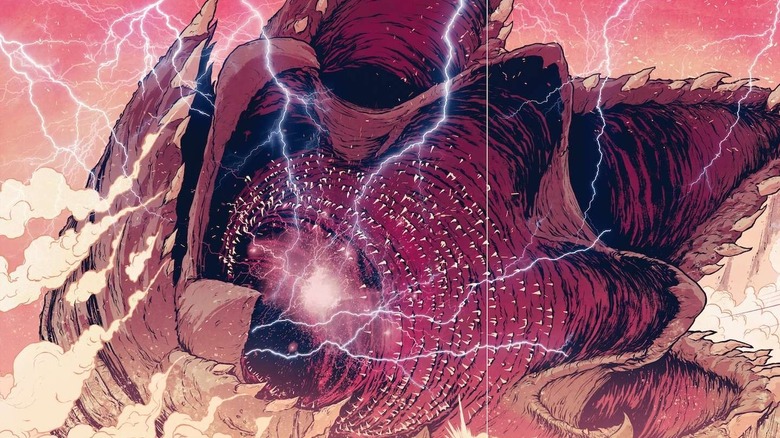The Proper Reading Order For Dune
Long before Denis Villeneuve's "Dune" burst onto the scene and captivated a legion of science fiction admirers, the pages of Frank Herbert's epic 1965 space opera novel had millions of fans invested in their story. Although Villeneuve's adaptation paints a relatively faithful portrait of sci-fi's resident sad boy Paul Atreides, there's nothing quite like the experience of reading Herbert's legendary series of novels. While many have been introduced to "Dune" through its many adaptations, experiencing the characters' journey, the visceral scenery of Caladan, the sand dunes of Arrakis, and its giant, almost-mythical sandworms coming to life through the written word is an experience every "Dune" fan should be able to have.
If you've been thinking about reading "Dune" — especially before Villeneuve's sequel arrives next year — you might see that finding the proper reading order is a perplexing ordeal of sorts. Herbert wrote five sequels to the original story, and after his death in 1986, his son, Brian Herbert, and sci-fi author Kevin J. Anderson published several prequel stories, which came to be known as "Prelude to Dune." Their writing partnership continued, and they later wrote two sequels (based on Herbert's notes discovered a decade later) and completed the original "Dune" series. And more. So you could read the entirety of Herbert's work to immerse yourself in the world of "Dune" or the first few books to prepare for the film. But, if you want to follow the stories of House Atreides and their adventures on Arrakis to the very end, you may have some work cut out for you. Here's the ideal reading order for the "Dune" series and its many prequels.
Dune by Frank Herbert
The first book in the epic series, "Dune," is set in the distant future in an intergalactic feudal society where royal houses control planetary fiefs. It tells the story of Paul Atreides, whose family is summoned to take control of the barren desert planet Arrakis. Despite having a brutal, inhabitable climate, it is the only site that produces melange or "spice," a psychedelic drug with life-enhancing abilities. It's also a resource used for interstellar travel, hence significantly valuable. Arrakis is inhabited by giant sandworms and an indigenous population known as the Fremen, who have learned to survive the planet's harsh environment over generations. The book follows House Atreides and their attempt to establish control of the planet, with the rival House Harkonnen threatening to destroy their efforts. Due to a prophecy, Paul is eventually targeted as a Messiah figure and worshipped by the people of Arrakis. The story is teeming with political warfare, themes of ecology and technology in our world, and religious fanaticism, among other things. It also features metaphors for the present-day — the empires in "Dune" are all struggling to take control of the one planet with the most valuable natural resource in their universe. I'm going to leave you with that.
Dune: Messiah by Frank Herbert
Herbert's first sequel is set 12 years after the events described in "Dune." Here, Paul "Mua'Dib" Atreides rules as Emperor after accepting the role of Messiah to the Fremen. An essential concept of the "Dune" series is Paul's concern that his rule will unleash a holy war (referred to as a jihad) led by the Fremen under his name. He's the most powerful Emperor the universe has ever known, but his word is defenseless against the religious juggernaut created by his ascension. Paul also has visions that suggest that their crisis is far from a disastrous future that awaits. He soon sets out on a journey to end the inevitable, acting as a ruler and a religious figure for the Fremen. In "Dune: Messiah," Herbert unmasks Paul's status as an all-powerful hero and Messiah while inverting everything his former novel stood for. "Should one man have that kind of power?" is a question the author unravels in this book.
Children of Dune by Frank Herbert
The story of the second sequel in the "Dune" series begins nine years after the events of "Dune: Messiah" and largely follows the story of Paul's twin children — who are heirs to their father's gifts — and have "prescient" visions of the fate of the universe. Their predictive abilities are coveted by their scheming aunt Alia, but Leto and Ghanima Atreides refuse to be anyone's puppets. "Children of Dune" dials up on deceitful relatives and themes of political intrigue as the Bene Gesserit endeavor to gain control of the spice and Paul's twins, and House Corrino plots to take control of the throne. Readers have often complained that "Children of Dune" is a very lengthy book — but its story is essential to read before moving on to its sequel.
God Emperor of Dune by Frank Herbert
Timeline wise, "God Emperor of Dune" is set 3,500 years after the former novel and takes place over a thousand years. Paul's son Leto II Atreides merges with a sandworm (weird, right?) to grant himself near-immortality; he's a "God Emperor" to his admirers and a tyrant to everyone else. As Leto II works towards preventing the extinction of humanity, a rebellion led by his rival family member threatens to dethrone him. You can expect to see more deceitful relatives in this one.
Heretics of Dune by Frank Herbert
"Heretics of Dune" jumps 1,500 years forward in time following the ending of the reign of God Emperor Leto II Atreides. The Known Universe is thrown into chaos. Severe famine in the world and the introduction of navigation machines cause billions of people to leave homes and wander into unknown space. This event, an explosion of humanity, is called the Scattering, which worsens following Leto II's death. The Bene Gesserit Sisterhood are compelled to make decisions that will dictate their future — to follow the Golden Path or keep their traditional roles of guiding human progress through hidden manipulation. And then there's a prophecy: a young girl who can control sandworms will return the Empire to its former glory. Read it to see if she succeeds!
Chapterhouse: Dune by Frank Herbert
"Chapterhouse: Dune" is an immediate sequel to "Heretics of Dune" and chronicles the Bene Gesserit sisterhood's trials and tribulations against the brutal Honored Matres, an aggressive matriarchal cult obsessed with power, violence, and sexual domination. Arrakis is destroyed, and the fate of the Empire rests in the hands of the Bene Gesserit women, who breed sandworms and seek to control spice production –- in the hope of remaking the galaxy for the future. The novel was published a year before Herbert's death and left the ending of the "Dune" series inconclusive for two decades before his son Brian Herbert and sci-fi author Kevin J. Anderson published two sequels based partly on notes left behind by Herbert for his planned seventh novel.
Hunters of Dune and Sandworms of Dune by Brian Herbert and Kevin J. Anderson
"Dune" readers had been yearning for the story to wrap up for years when Brian Herbert and Anderson came to their disposal. The writers co-authored the two concluding novels of the "Dune" series with insight from a long-lost outline discovered in one of Herbert's safety deposits. "Hunters of Dune" and "Sandworms of Dune" follow up on the themes explored in the last few books about the danger to humanity from a remote, unidentified, and everpresent "great enemy." All burning questions pertaining to the future of Arrakis and the consequences of a war between Man and Machine are laid to rest. This is where Herbert's space opera comes to an end.
If you're still hoping to continue immersing yourself in the world of Frank Herbert's deep-rooted sci-fi world, there are several short stories and prequels that might interest you.
Prelude to Dune by Brian Herbert and Kevin. J Anderson
Brian Herbert and Kevin J. Anderson's first "Dune" collaboration began a little over a decade after Frank Herbert's death. They wrote three direct prequel novels to "Dune" that exists as a buildup to the book's noteworthy events and set the ball rolling for all of the story's mythology. They establish a foundation leading up to the battle over Arrakis — it focuses on the characters of Shaddam and Baron Harkonnen. It also summarizes Duke Leto's rise to power (as seen in the first book).
Here's the reading order for the books:
1) "Dune: House Atreides"
2) "Dune: House Harkonnen"
3) "Dune: House Corrino"
Legends of Dune by Brian Herbert and Kevin J. Anderson
Brian Herbert and Kevin J. Anderson's commitment to the "Dune" universe is a gift that keeps on giving. "Legends of Dune" is another prequel trilogy that outlines a conflict 10,000 years before the events of "Dune" and sets up the origin of the Known Universe's culture through the lens of a war struck between humanity and machines, which is referred to as "The Butlerian Jihad." The origins of major organizations like the Bene Gesserit, Spacing Guild, and House Corrino, whose Padishah Emperors ruled the universe until "Dune," are explored in these novels. You can read these books independently because they're unrelated to the "Dune" universe regardless of them becoming core parts of the series later on.
Here's the reading order for the books:
1) "The Butlerian Jihad"
The last free humans are seen opposing the thinking machines.
2) "The Machine Crusade"
The thinking machines fight back, and the outlaws on Arrakis take the first steps to establish themselves as Fremen.
3) "The Battle of Corrin"
The final apocalyptic showdown between humans and robots comes to life.
Heroes of Dune by Brian Herbert and Kevin J. Anderson
The "Heroes Of Dune" is a duology set in the time of the Corrino Empire and the Ascencion of House Atreides. Think of these as books that cover the missed time — the gaps — between Herbert's original novels. They also feature flashbacks to Paul's childhood.
Here's the reading order for the two books:
1) "Paul of Dune"
Divided into seven sections, "Paul of Dune" alternates between two time periods. The first is set five years before House Atreides moved to Arrakis, and the second involves the life of the Mua'Dib (and the spreading of the holy war) following his ascension as Emperor of the Known Universe.
2) "The Winds of Dune"
The second book covers the life of Lady Jessica at the time when she returns to Arrakis to probe the disappearance of her son Paul, which takes place at the end of "Dune: Messiah."
Great Schools of Dune by Brian Herbert and Kevin J. Anderson
A direct sequel to the "Legends of Dune" trilogy, "Great Schools of Dune," is set in the century following "The Battle of Corrin." It outlines the formation of various organizations from the original "Dune" book. The titles refer to the Bene Gesserit Sisterhood, the Mentats (human computers that were developed to replace thinking machines), and the Spacing Guild.
Here's the reading order:
1) "Sisterhood of Dune"
2) "Mentats of Dune"
3) "Navigators of Dune"
The Caladan Trilogy Brian Herbert and Kevin J. Anderson
The most recent "Dune" spin-off trilogy features three books that chronicle the lives of the Atreides. There's a prequel about Leto Atreides (which follows his narrative from a quiet ruler to a power player in the Known Universe). Another prequel story follows Lady Jessica's journey and adventures in the year before the events of "Dune." A third book is set to be released later this year and serves as a deep dive into the life of Paul Atreides and his transformation from a teenager to a messiah.
Here's the reading order:
1) "The Duke of Caladan"
2) "The Lady of Caladan"
3) "The Heir of Caladan" (to be released in late 2022)
Wait ... there are graphic novels too!
Why stop at novels when you can expand into different mediums? It appears that there's no stopping Brian Herbert and Kevin J. Anderson.
There are two graphic novels that feature Raúl Allén and Patricia Martín's intricately illustrated scenes from the book, with a stunning visual language partly covering the first book. While the first one explores the adventures on Arrakis, the second sees Lady Jessica and Paul stranded on the desert planet after being overthrown by House Harkonnen. It's beautiful and a great gift that any "Dune" fan will thoroughly enjoy having.
Here's the reading order:
1) "Dune: The Graphic Novel"
2) "Dune: The Graphic Novel, Book 2: Muad'Dib"
"Dune" is an epic, sprawling series that has captured readers' attention for decades, long after the first book was published. With the book's big-screen adaptation gaining popularity and critical-acclaim, more and more people are falling in love with the unique world. If you find yourself to be an aspiring "Dune" superfan who wants to discover Paul's story from the beginning, getting started on the books right away is your best plan.
Happy reading!
